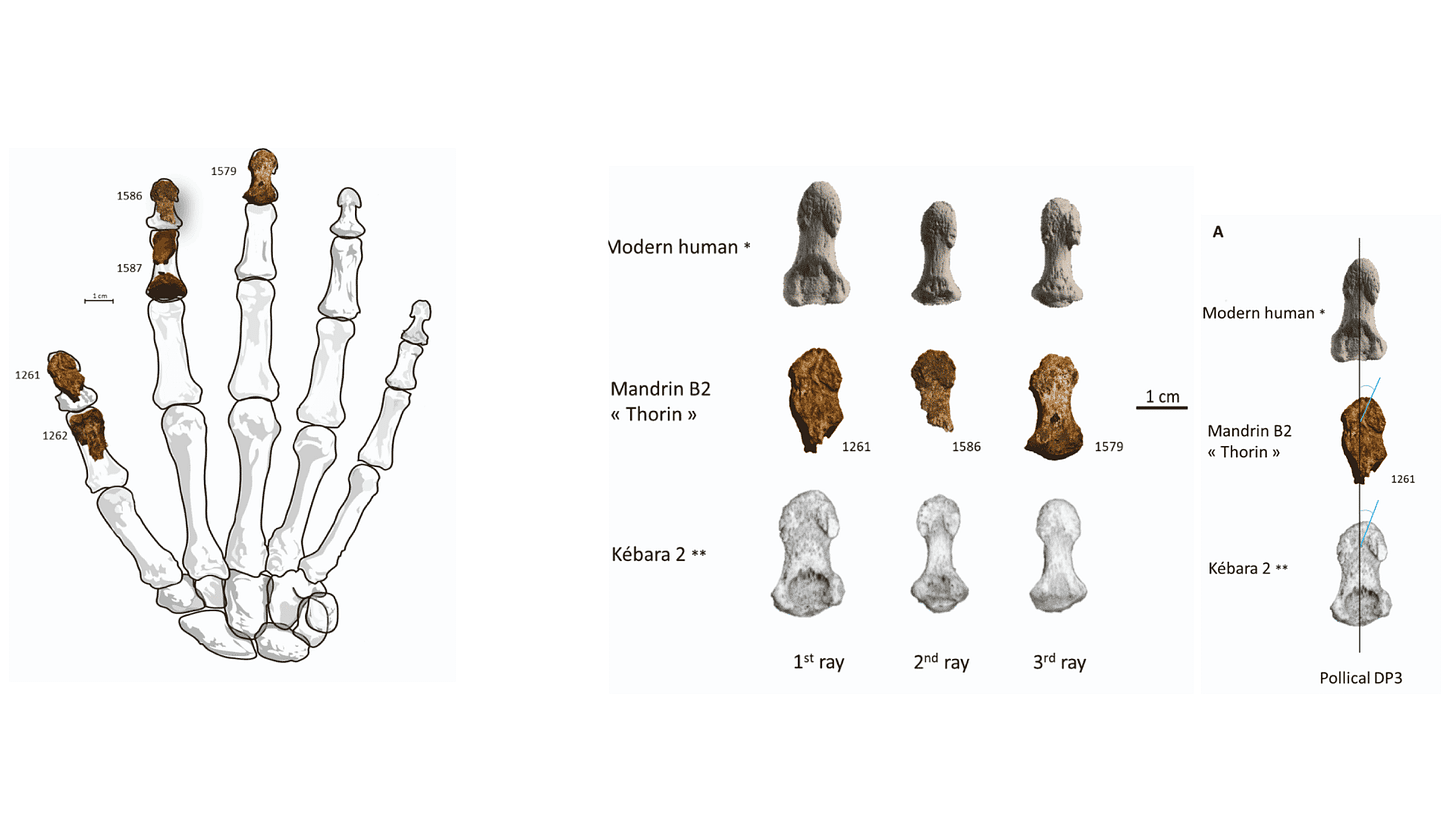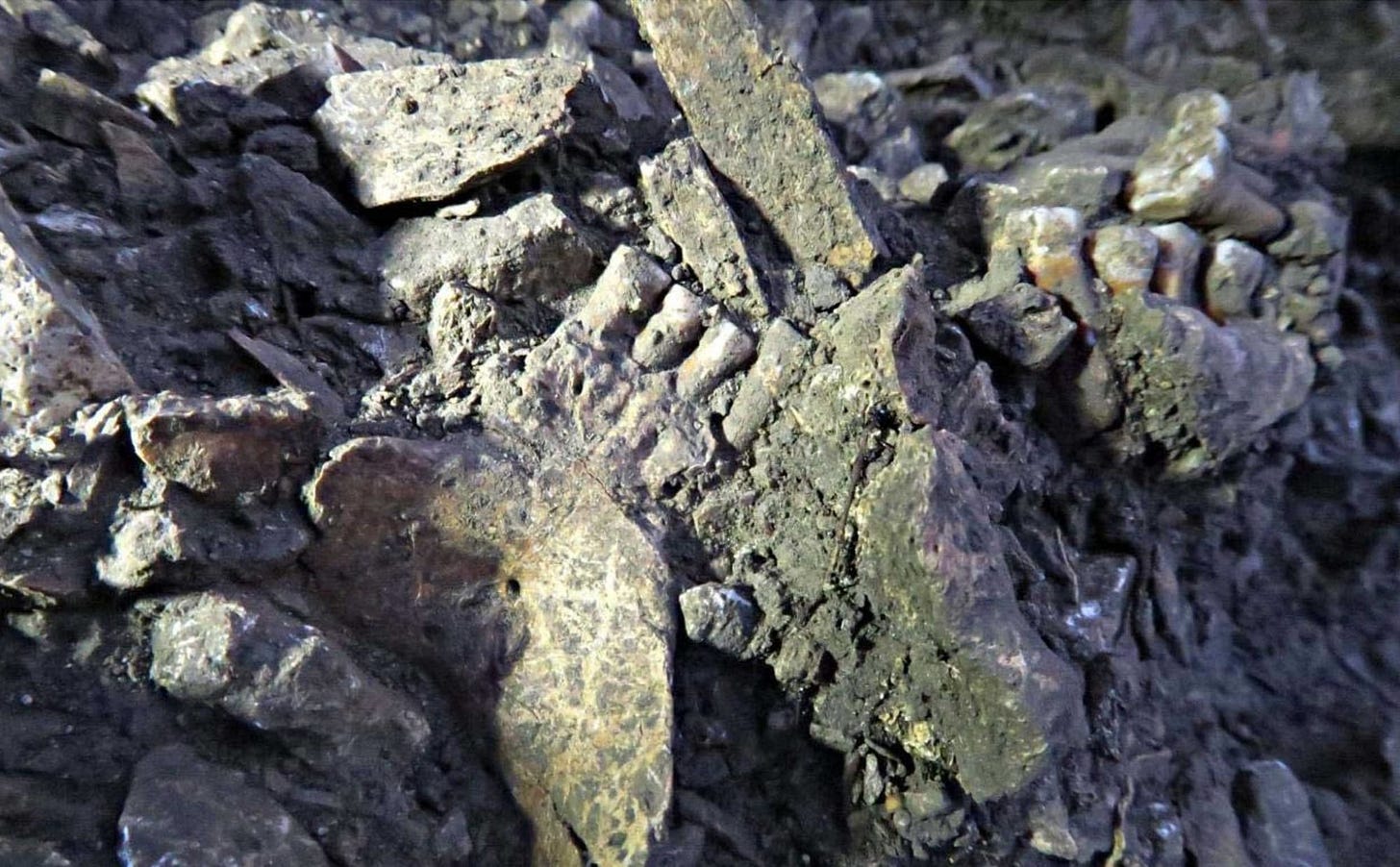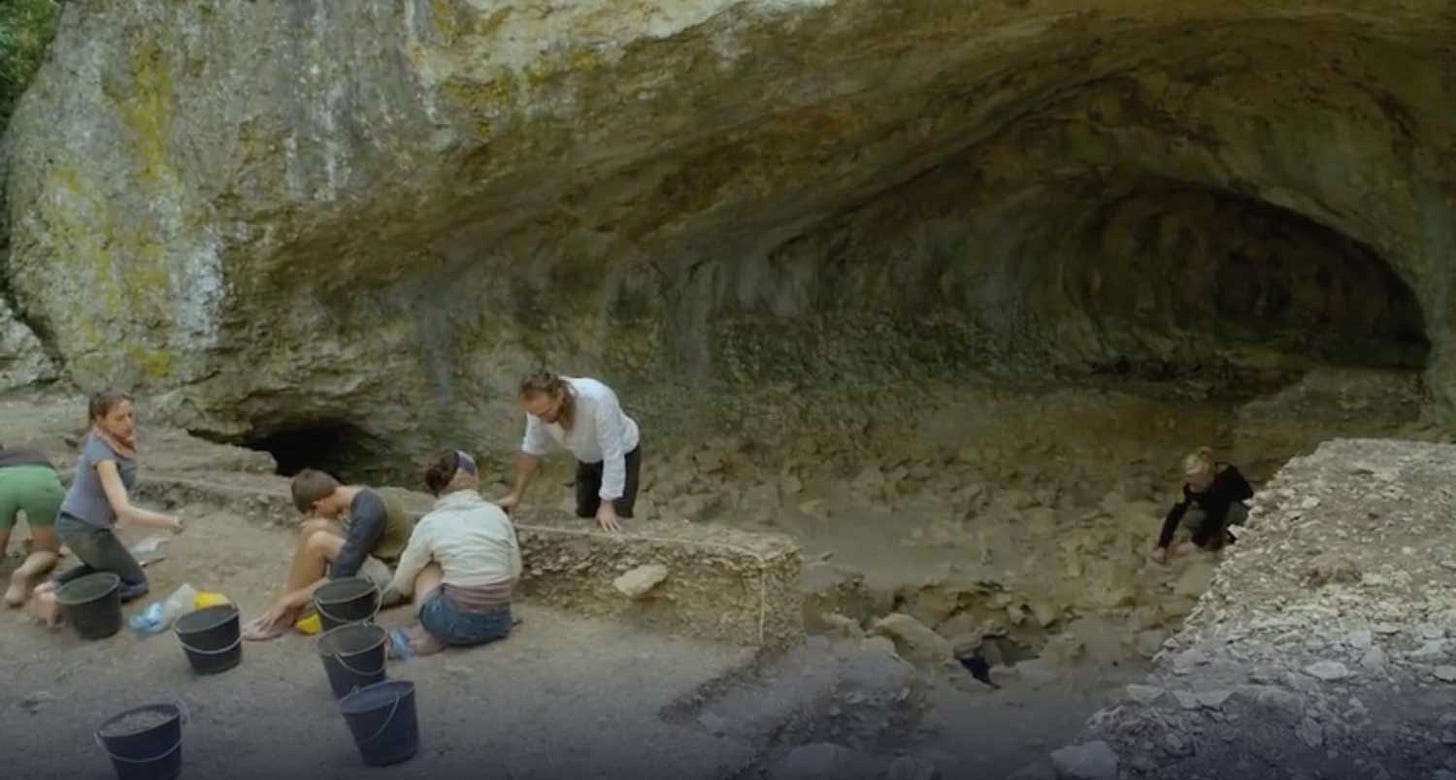The impressive genetic diversity of the last Neanderthals
The new “Thorin” genome from Grotte Mandrin represents a previously-unknown Neanderthal deep history.
In 2024, Cell Genomics published the manuscript describing the “Thorin” genome from Grotte Mandrin, France. The work had been released in preprint form by Ludovic Slimak and coworkers in April, 2023, and it’s one of the many cases that reinforces what I've been telling my PhD students: the journey from submission to publication for human evolution research is now routinely taking 18 months or more.
For me it was a little jarring to read news stories about this paper. They all started off with the wrong idea about what genetic variation can tell us about Neanderthals. Headline after headline pointed to “50,000 years of isolation”. Scientists in these stories were floating the ridiculous idea that different groups of Neanderthals were next-door neighbors for thousands of generations without ever mixing. That's just wrong.
Instead, what I find exciting about the Mandrin B2 “Thorin” genome clarifies a component of genetic history that wasn't noticed before. For more than a decade we’ve had fragmentary genetic knowledge about diversity of Neanderthals that lived earlier in time, from places like Denisova Cave. Meanwhile, the Neanderthals from later than 60,000 years ago—way better known from skeletal remains than earlier groups—seemed to represent only a single surviving branch of the earlier groups.
The Thorin data show that these fragments of information were just that, fragments. The last Neanderthals were also genetically diverse.
Wait a minute! I can imagine people saying. The Thorin paper shows that this individual was inbred. How can that possibly mean the Neanderthals were actually diverse?
That's what I mean when I say that the headlines have the wrong idea about genetic variation. What ancient genomes actually show is that the variation of past humans like the Neanderthals was structured differently than recent humans.
Within-group and within-genome variation
We already knew there was diversity among earlier Neanderthals, because of the great degree of genetic differences between later Neanderthals like Vindija 33.19 and the earlier Denisova 5 genome, otherwise known as the “Altai Neanderthal”. In the last few years researchers have developed quite a bit of evidence about the genetic changes among early Neanderthals, including the widespread introgression of African DNA into their populations.
But while the Altai Neanderthal genome was different from other Neanderthals, its within-genome variation is low. This female individual had more than 300 megabases—a tenth of its genome—in long runs of homozygosity of 8 megabases or more. From this it is clear that her parents were closer relatives than would be usual in most, but not all, recent human ethnic groups. Small local group size sometimes contributes to this kind of inbreeding, and cultural preferences about marriage and childrearing also may contribute.
The Thorin genome with around 100 megabases in long runs of homozygosity is not so extreme. Its genome-wide pattern is similar to people from traditional groups where cousin marriage is frequently practiced.

One fascinating detail of the Thorin individual is an extra pair of mandibular molars. This is an extremely rare trait in today's humans, and in other primates. Slimak and collaborators mention that occasionally hybrid individuals between other species of primates have been seen with fourth molars, citing 2011 work by Rebecca Ackermann. I think it's an interesting characteristic of this individual but there's not any specific reason to link the trait to inbreeding, as I've seen in some of the press reporting on the Thorin paper.
Between-population variation
Between-population genetic variation is a second aspect of Neanderthal population structure. A simple measure is counting differences between genomes from different populations, but those differences actually reflect three historical components: the time since the populations first diverged, the amount of gene flow after they diverged, and the genetic variation shared by both populations from their common ancestors. The last of these is just within-population variation from both populations' shared past. So to consider the between-population components, geneticists do more than just count, they fit data to a population model.
Slimak and coworkers applied a model to estimate when the populations ancestral to the Thorin genome and the high-coverage Vindija 33.19 genome might have diverged. That estimate is just before 100,000 years ago, The Thorin individual lived sometime between around 52,000 and 48,000 years ago. The Neanderthals from Vindija, Croatia, were slightly later in time, meaning that the shared common ancestors of Vindija 33.19 and Thorin lived around 50,000 years earlier than either of these individuals.
A similar population model applied to today's people in Croatia and southern France would show a vastly shorter time since the common ancestors of these two regional populations. Neanderthals had a much deeper population structure than recent Europeans.

But today's Europeans have a relatively recent founding and strongly intertwined history. The among-population diversity of Neanderthals is less exceptional when compared to today's African peoples. Rainforest hunter-gatherer populations, Khoesan-speaking populations of southern Africa, and other groups in western and eastern Africa today all derive from ancestral populations that separated before 50,000 years ago. Work by Mark Lipson and coworkers on ancient genomes from Cameroon suggested that the present-day diversity of African groups reflects four ancestral populations that diversified before 200,000 years ago. Likewise, deep diversification is inferred for Denisovan groups, which are known from ancient DNA and from the footprints of ancient mixture in today's peoples of eastern Asia and island southeast Asia. Compared to the African and Denisovan patterns, Neanderthals still have lower between-population variation.
Dynamic populations
This brings me to a third aspect of population structure: static versus dynamic structure. Grotte Mandrin and Vindija are around 1000 km from each other. Genomes from these two places seem like they should be closer to each other than either is to Chagyrskaya Cave, nearly 6000 km from Vindija. But that's not what we see. Instead, the Vindija 33.19 and Chagyrskaya 8 genomes share more recent ancestry and Thorin is the odd genome out.
If the population structure was static, not changing over time, then this pattern of similarities and differences would suggest some kind of barrier reduced gene flow between Neanderthals in Croatia and southern France. But in my view the situation is more easily explained by a dynamic population structure, in which some populations expanded in geographic range while others contracted over time.
The dynamic explanation has long been at play for the central Asian Neanderthals. For example, while Thorin and Vindija 33.19 are fairly different from each other, the genome of Denisova 5, known as the “Altai Neanderthal”, diverges from both. Denisova Cave is less than 200 km from Chagyrskaya Cave. But the Denisova 5 individual lived thousands of years earlier than Chagyrskaya 8. The great difference between Denisova 5 and Chagyrskaya 8 is easily explained if the common ancestors of Vindija and Chagyrskaya Neanderthals expanded their geographic range into areas that earlier were occupied by more distantly related groups. In the dynamic scenario, the Altai saw a succession of different Neanderthal populations.
It wasn't only Neanderthals. Other evidence from Denisova Cave shows that multiple Denisovan populations left biological evidence within this one site over hundreds of thousands of years. The Denisova 11 hybrid individual, with a Neanderthal mother and Denisovan father, shows that these groups sometimes were in the area at the same time.

As I've mentioned here before, one reason why such a succession of different populations might be found in central Asia is that the region was a long-term population sink (Climate models, Neanderthals, and Denisovans). In other geographic areas Neanderthal and Denisovan populations may have been better-fitted to the local circumstances, enabling the populations in those areas to grow consistently. People from these source populations tended to move as conditions became locally crowded, sometimes into areas where long-term conditions were less stable, or less well-fitted to the biology of these hominins. The sinks were places where groups could not persist for thousands of generations. Gene flow tended to be directional away from sources, much less able to propagate across the sinks. This process would likely have been episodic, as climate and other influences on local conditions fluctuated across centuries or millennia.
So it's nonsensical to say that the Thorin lineage proves that two Neanderthal groups were isolated for more than 50,000 years only a few days' journey apart. That notion assumes a static population. In reality the populations were dynamic.
The reason why Thorin's ancestors and the ancestors of Vindija 33.19 didn't mix much is not because the Neanderthals never crossed a ridgeline into the next valley. Each genome is a sample of a population, an echo of the population's ancestors. For western European Neanderthals around 50,000 years ago, the pattern simply means that some of their ancestors came from somewhere else.
These were populations that exploded across thousands of miles of central Asia and Europe. The earlier connections of the Vindija and similar genomes are with Mezmaiskaya and Chagyrskaya. That makes it a good guess that the ancestors of these Neanderthals came from the east. One thing we don't know yet is whether the Neanderthal-like fossils of southwest Asia, like those from Shanidar Cave, are connected with any of these European or central Asian populations. It's possible those groups have their own divergent deep histories.
Quantifying the realistic levels of mixture across this large Neanderthal geographic range is a challenge with the few ancient DNA samples. Slimak and coworkers include some analyses in their supplementary information that examine possible mixture between some far-flung populations. One of those analyses suggests that Chagyrskaya 8 may have had some mixture from an Altai Neanderthal-like population, despite the tens of thousands of years between them. They also find that the Les Cottes Z4-1514 individual may have had mixture from another deep population lineage, distant from Vindija 33.19, but possibly closer to Thorin.
These observations are just hints about mixture, though, because the ancient DNA data do not sample fully the diversity of later Neanderthals. The Thorin genome itself is strong evidence that more may remain to be found.

Bottom line
“Long genetic and social isolation in Neanderthals before their extinction” is the title of Slimak and coauthors' article. This title calls back to an old idea. According to this idea, Neanderthals evolved anatomical specialization in Europe while isolated from humans in other regions. Many anthropologists have written about this idea. Some scientists over the years challenged it.
The Thorin genome suggests that the Neanderthals of 50,000 years ago were not a dwindling relict. The deep histories of their populations were like small-scale human populations that still live in Africa. The Thorin genome increases our estimate of genetic variation across the Neanderthal geographic and temporal range. Later Neanderthals were more like earlier Neanderthals in diversity than we knew. Meanwhile, Neanderthal mating patterns seem to have been like small-scale human groups that practice cousin marriage.
Some might say that I'm avoiding the real issue. Individual Neanderthal genomes had higher homozygosity than the average human living today, a result of high genetic drift in local populations. Purifying selection against deleterious genetic variants was weaker. The buildup of deleterious variants may impede survival and reproduction, a phenomenon known as genetic load. Some researchers have suggested that such deleterious variants could not persist in human populations, limiting our Neanderthal genetic heritage.
But Neanderthals somehow made this demographic situation work for hundreds of thousands of years. They evidently had substantial genetic resilience. Population sources were an important part of this, enabling the persistence of somewhat divergent gene pools. The Thorin genome is a valuable clue. Divergent populations are repositories for genetic variation. Mixture between divergent populations—even rarely—provided opportunities for the rescue of small populations from genetic load. New variants might sometimes correct the biological problems caused by the buildup of deleterious variants. Again, occasional interbreeding would spread such adaptive variants.
Deep lineage diversity characterized regional populations of humans throughout our Pleistocene history. Within Africa, among Denisovans, and among Neanderthals, we can see deep branches. Thorin's genome shows that late European Neanderthals had at least two deep branches. That's one more than we knew about two years ago.
Notes: The topic of how inbred Neanderthals were deserves its own post. There's quite a lot of interesting data from recent human populations that illuminates the extent of genealogical relationships between parents of children.
I've included some references that discuss the depth of population history in Africa and among Denisovans. This is a big topic and the literature has not tackled the fact that these different populations show quite similar Pleistocene patterns. The reference from Aaron Ragsdale and coworkers, which I discussed here last year, points out that most approaches do not actually distinguish long-term isolation of lineages—including supposed “ghost populations”—from isolation-by-distance or other hypotheses with restricted gene flow. Declaring 50,000 years of isolation based on a single genome is not generally realistic unless models with long-term gene flow are clearly rejected by the data.
References
Ackermann, R. R. (2010). Phenotypic traits of primate hybrids: Recognizing admixture in the fossil record. Evolutionary Anthropology: Issues, News, and Reviews, 19(6), 258–270. https://doi.org/10.1002/evan.20288
Fan, S., Spence, J. P., Feng, Y., Hansen, M. E. B., Terhorst, J., Beltrame, M. H., Ranciaro, A., Hirbo, J., Beggs, W., Thomas, N., Nyambo, T., Mpoloka, S. W., Mokone, G. G., Njamnshi, A. K., Fokunang, C., Meskel, D. W., Belay, G., Song, Y. S., & Tishkoff, S. A. (2023). Whole-genome sequencing reveals a complex African population demographic history and signatures of local adaptation. Cell, 186(5), 923-939.e14. https://doi.org/10.1016/j.cell.2023.01.042
Jacobs, G. S., Hudjashov, G., Saag, L., Kusuma, P., Darusallam, C. C., Lawson, D. J., Mondal, M., Pagani, L., Ricaut, F.-X., Stoneking, M., Metspalu, M., Sudoyo, H., Lansing, J. S., & Cox, M. P. (2019). Multiple Deeply Divergent Denisovan Ancestries in Papuans. Cell, 177(4), 1010-1021.e32. https://doi.org/10.1016/j.cell.2019.02.035
Prüfer, K., Racimo, F., Patterson, N., Jay, F., Sankararaman, S., Sawyer, S., Heinze, A., Renaud, G., Sudmant, P. H., de Filippo, C., Li, H., Mallick, S., Dannemann, M., Fu, Q., Kircher, M., Kuhlwilm, M., Lachmann, M., Meyer, M., Ongyerth, M., … Pääbo, S. (2014). The complete genome sequence of a Neanderthal from the Altai Mountains. Nature, 505(7481), 43–49. https://doi.org/10.1038/nature12886
Ragsdale, A. P., Weaver, T. D., Atkinson, E. G., Hoal, E. G., Möller, M., Henn, B. M., & Gravel, S. (2023). A weakly structured stem for human origins in Africa. Nature, 1–9. https://doi.org/10.1038/s41586-023-06055-y
Schlebusch, C. M., Sjödin, P., Breton, G., Günther, T., Naidoo, T., Hollfelder, N., Sjöstrand, A. E., Xu, J., Gattepaille, L. M., Vicente, M., Scofield, D. G., Malmström, H., de Jongh, M., Lombard, M., Soodyall, H., & Jakobsson, M. (2020). Khoe-San Genomes Reveal Unique Variation and Confirm the Deepest Population Divergence in Homo sapiens. Molecular Biology and Evolution, 37(10), 2944–2954. https://doi.org/10.1093/molbev/msaa140
Slimak, L., Vimala, T., Seguin-Orlando, A., Metz, L., Zanolli, C., Joannes-Boyau, R., Frouin, M., Arnold, L. J., Demuro, M., Devièse, T., Comeskey, D., Buckley, M., Camus, H., Muth, X., Lewis, J. E., Bocherens, H., Yvorra, P., Tenailleau, C., Duployer, B., … Sikora, M. (2024). Long genetic and social isolation in Neanderthals before their extinction. Cell Genomics, 4(9). https://doi.org/10.1016/j.xgen.2024.100593
Zavala, E. I., Jacobs, Z., Vernot, B., Shunkov, M. V., Kozlikin, M. B., Derevianko, A. P., Essel, E., de Fillipo, C., Nagel, S., Richter, J., Romagné, F., Schmidt, A., Li, B., O’Gorman, K., Slon, V., Kelso, J., Pääbo, S., Roberts, R. G., & Meyer, M. (2021). Pleistocene sediment DNA reveals hominin and faunal turnovers at Denisova Cave. Nature, 595(7867), Article 7867. https://doi.org/10.1038/s41586-021-03675-0



